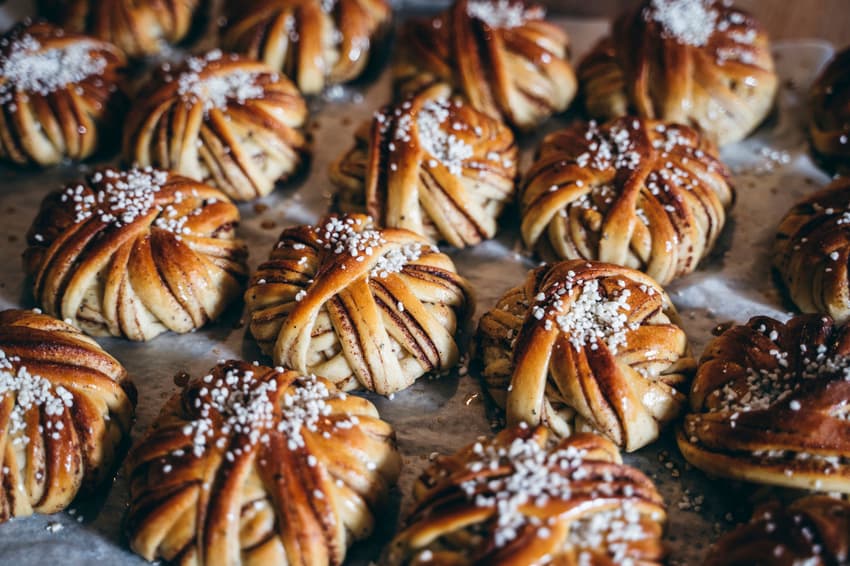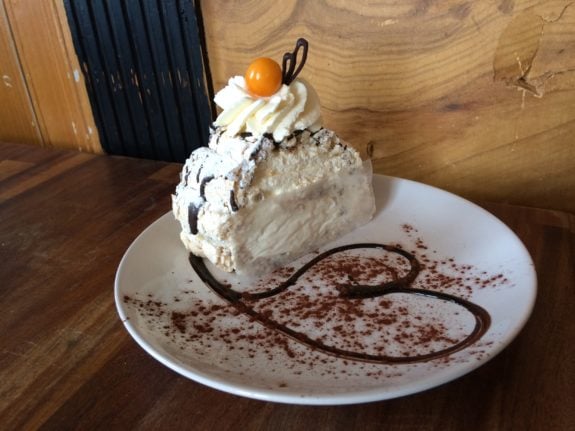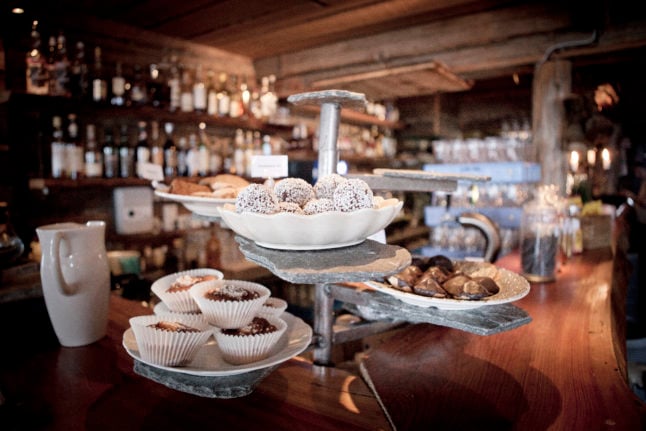Five sweet treats you should be able to identify if you live in Sweden

Do you know your biskvi from your bakelse? Your chokladboll from your kanelbulle? Here's a guide guaranteed to get your mouth watering.
Kanelbulle
The most famous of all Swedish cakes outside Sweden, the classic kanelbulle (cinnamon bun) is the symbol of Sweden abroad, no doubt helped by the fact that Swedish furniture giants IKEA stock frozen buns in their food stores for customers to bake off at home.
Forget American tear-apart cinnamon rolls baked in a pan and slathered with cream cheese frosting: a classic Swedish cinnamon bun is baked individually using a yeasted dough spread with cinnamon sugar and butter. The dough is then rolled up and sliced into strips which are stretched out and knotted into buns, baked, glazed with sugar syrup and sprinkled with pearl sugar.
Home-made varieties skip the stretching and knotting step, rolling the cinnamon-sprinkled dough into a spiral instead which, although less traditional, tastes just as good.
Kanelbullar in Sweden often include a small amount of Sweden's favourite spice: cardamom. If you're a fan of cardamom, try ordering the kanelbulle's even more Swedish cousin, the kardemummabulle or cardamom bun, which skips the cinnamon entirely and goes all-out on cardamom instead.
Sweden celebrates cinnamon bun day (kanelbullens dag) on October 4th.
Photo: Lieselotte van der Meijs/imagebank.sweden.se
Chokladboll
A great option if you want a smaller cake for your fika, the chokladboll or 'chocolate ball' is a perfect accompaniment to coffee - some recipes even call for mixing cold coffee into the batter.
They aren't baked and are relatively easy to make, meaning they are a popular choice for adults wanting to involve children in the cake-making process.
Chokladbollar are a simple mix of sugar, oats, melted butter and cocoa powder, with the optional addition of vanilla or coffee, or occasionally rum extract. They are rolled into balls which are then rolled in desiccated coconut (or occasionally pearl sugar), and placed in the fridge to become more solid.
Some bakeries or cafés also offer dadelbollar or rawbollar/råbollar (date or raw balls), a vegan alternative made from dried dates and nuts blended together with cocoa powder.
Chocolate ball day (chokladbollens dag) falls on May 11th.
Photo: Magnus Carlsson/imagebank.sweden.se
Prinsesstårta
The lime-green prinsesstårta or 'princess cake' may look like a modern invention with it's brightly-coloured marzipan covering, but it has been around since the beginning of the 1900s, and is named after three Swedish princesses, Margareta, Märta and Astrid, who were supposedly especially fond of the cake.
The cake consists of a sponge bottom spread with jam, crème pâtissière and a dome of whipped cream, covered in green marzipan and some sort of decoration, often a marzipan rose.
Prinsesstårtor can also be served in individual portions, small slices of a log which are then referred to as a prinsessbakelse.
Although the cakes are popular all year round, in the Swedish region of Småland, prinsesstårta is eaten on the first Thursday in March, due to this being the unofficial national day of the Småland region (as the phrase första torsdagen i mars is pronounced fössta tossdan i mass in the Småland dialect).
Since 2004, the Association of Swedish Bakers and Confectioners has designated the last week of September as prinsesstårtans vecka (Princess cake day).
Budapestbakelse
Belonging to the more traditional cakes, a Budapestbakelse or "Budapest slice" is a type of rulltårta or "roll cake" similar to a Swiss roll, consisting of a light and crispy cake made from whipped egg whites, sugar and hazelnut, filled with whipped cream and fruit – often chopped conserved peaches, nectarines or mandarines – and rolled into a log.
The log is then sliced into individual portions and drizzled with chocolate, then topped with whipped cream and a slice of fruit.
Despite its name, the Budapest slice has nothing to do with the city of Budapest - it was supposedly invented by baker Ingvar Strid in 1926 and received the name due to Strid's love for the Hungarian capital.
Of course, the Budapestbakelse also has its own day - May 1st.
Kanelbullar (left), chokladbollar (centre) and biskvier (right). Photo: Tuukka Ervasti/imagebank.sweden.se
Biskvi
Another smaller cake, a biskvi (pronounced like the French biscuit), consists of an almond biscuit base, covered in buttercream (usually chocolate flavoured), and dark chocolate.
Different variants of biskvier exist, such as a Sarah Bernhardt, named after the French actress of the same name, which has chocolate truffle instead of buttercream.
You might also spot biskvier with white chocolate, often with a hallon (raspberry) or citron (lemon) filling, or even saffransbiskvier (saffron biskvis) around Christmastime.
Chokladbiskviens dag is celebrated on November 11th.
Comments
See Also
Kanelbulle
The most famous of all Swedish cakes outside Sweden, the classic kanelbulle (cinnamon bun) is the symbol of Sweden abroad, no doubt helped by the fact that Swedish furniture giants IKEA stock frozen buns in their food stores for customers to bake off at home.
Forget American tear-apart cinnamon rolls baked in a pan and slathered with cream cheese frosting: a classic Swedish cinnamon bun is baked individually using a yeasted dough spread with cinnamon sugar and butter. The dough is then rolled up and sliced into strips which are stretched out and knotted into buns, baked, glazed with sugar syrup and sprinkled with pearl sugar.
Home-made varieties skip the stretching and knotting step, rolling the cinnamon-sprinkled dough into a spiral instead which, although less traditional, tastes just as good.
Kanelbullar in Sweden often include a small amount of Sweden's favourite spice: cardamom. If you're a fan of cardamom, try ordering the kanelbulle's even more Swedish cousin, the kardemummabulle or cardamom bun, which skips the cinnamon entirely and goes all-out on cardamom instead.
Sweden celebrates cinnamon bun day (kanelbullens dag) on October 4th.
Chokladboll
A great option if you want a smaller cake for your fika, the chokladboll or 'chocolate ball' is a perfect accompaniment to coffee - some recipes even call for mixing cold coffee into the batter.
They aren't baked and are relatively easy to make, meaning they are a popular choice for adults wanting to involve children in the cake-making process.
Chokladbollar are a simple mix of sugar, oats, melted butter and cocoa powder, with the optional addition of vanilla or coffee, or occasionally rum extract. They are rolled into balls which are then rolled in desiccated coconut (or occasionally pearl sugar), and placed in the fridge to become more solid.
Some bakeries or cafés also offer dadelbollar or rawbollar/råbollar (date or raw balls), a vegan alternative made from dried dates and nuts blended together with cocoa powder.
Chocolate ball day (chokladbollens dag) falls on May 11th.
Prinsesstårta
The lime-green prinsesstårta or 'princess cake' may look like a modern invention with it's brightly-coloured marzipan covering, but it has been around since the beginning of the 1900s, and is named after three Swedish princesses, Margareta, Märta and Astrid, who were supposedly especially fond of the cake.
The cake consists of a sponge bottom spread with jam, crème pâtissière and a dome of whipped cream, covered in green marzipan and some sort of decoration, often a marzipan rose.
Prinsesstårtor can also be served in individual portions, small slices of a log which are then referred to as a prinsessbakelse.
Although the cakes are popular all year round, in the Swedish region of Småland, prinsesstårta is eaten on the first Thursday in March, due to this being the unofficial national day of the Småland region (as the phrase första torsdagen i mars is pronounced fössta tossdan i mass in the Småland dialect).
Since 2004, the Association of Swedish Bakers and Confectioners has designated the last week of September as prinsesstårtans vecka (Princess cake day).
Budapestbakelse
Belonging to the more traditional cakes, a Budapestbakelse or "Budapest slice" is a type of rulltårta or "roll cake" similar to a Swiss roll, consisting of a light and crispy cake made from whipped egg whites, sugar and hazelnut, filled with whipped cream and fruit – often chopped conserved peaches, nectarines or mandarines – and rolled into a log.
The log is then sliced into individual portions and drizzled with chocolate, then topped with whipped cream and a slice of fruit.
Despite its name, the Budapest slice has nothing to do with the city of Budapest - it was supposedly invented by baker Ingvar Strid in 1926 and received the name due to Strid's love for the Hungarian capital.
Of course, the Budapestbakelse also has its own day - May 1st.
Biskvi
Another smaller cake, a biskvi (pronounced like the French biscuit), consists of an almond biscuit base, covered in buttercream (usually chocolate flavoured), and dark chocolate.
Different variants of biskvier exist, such as a Sarah Bernhardt, named after the French actress of the same name, which has chocolate truffle instead of buttercream.
You might also spot biskvier with white chocolate, often with a hallon (raspberry) or citron (lemon) filling, or even saffransbiskvier (saffron biskvis) around Christmastime.
Chokladbiskviens dag is celebrated on November 11th.




Join the conversation in our comments section below. Share your own views and experience and if you have a question or suggestion for our journalists then email us at [email protected].
Please keep comments civil, constructive and on topic – and make sure to read our terms of use before getting involved.
Please log in here to leave a comment.